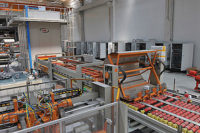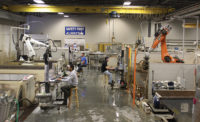
Pokarna Limited developed a state-of-the-art facility for producing its own line of quartz surfacing - named Quantra - in Vishakapatnam, India.
Capitalizing on the growing popularity of quartz surfacing, Pokarna Limited through its wholly owned subsidiary, Pokarna Engineered Stone Limited (PESL), has launched a new quartz product line - Quantra - and it is being processed at a new factory in Vishakapatnam, India, using the Bretonstone System from Breton S.p.A. of Italy, which is considered to be among the finest of its kind in the world.
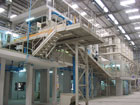
During the production process, raw materials - including quartz, resin, catalyst and other elements - are delivered to one of four mixers. The presence of four mixers allows Pokarna to use up to four colors in a single slab of material.
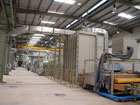
Materials are distributed into a rubber mold and pressed into slabs using a high-vibration vacuum press. The slabs then cure in a kiln for 25 minutes, and the mold is automatically separated from the slabs before they move to a cooling chamber.
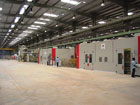
The polishing process for quartz slabs is similar to that used for raw granite slabs coming off a gangsaw, except the slabs first pass through a calibration area that includes two Levibreton KCP units to calibrate both sides of the slab.
The production process
Overall, Pokarna’s facility for manufacturing Quantra sits on 40 acres of property, and the production line was built over an area of 8 acres, explained Siddharth Jain, Executive Director of Pokarna.
The standard size for slab production is 305 x 140 cm, with custom sizes also available, and slabs are available in a 3- or 2-cm format.
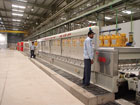
The next step is grinding, using a Levibreton KCP unit with 18 working heads. A polished surface is then furnished by passing the slabs through a second Levibreton KCP unit, also with 18 working heads.

In addition to looking for color or physical defects, the quality-control specialist also checks the slabs with a micrometer and a gloss meter.
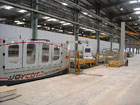
In addition to slabs, the Quantra factory produces tiles on a line that begins using a Breton JoyCut FB/NC 500 cutting unit and continues with the various chamfering and beveling processes. Tiles are available in standard sizes of 30 x 30, 40 x 40 and 60 x 60 cm in a 12-mm thickness, and custom sizes are available on request.
The next step is grinding, using a Levibreton KCP unit with 18 working heads. A polished surface is then furnished by passing the slabs through a second Levibreton KCP unit, also with 18 working heads. A shot-blasting unit also allows Pokarna to offer the Quantra product with sand-blasted finish. They also offer slabs in “honed,” “leather,” “egg,” “velvet” and other textured finishes. Additionally, a UV treatment can automatically be applied so the Quantra products can be used for exterior applications.
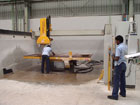
A Breton SpeedyCut FK NC 800 programmable bridge saw is used for cut-to-size work.

Architectural work is also processed using a Breton NC 260 K23 CNC stoneworking center.
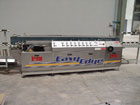
The edges of the quartz pieces are processed as needed using an EasyEdge from Breton.
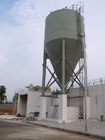
Pokarna recycles and recovers 100% of the water used during the manufacturing process.
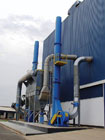
Also with an eye on the environment, the factory is equipped with a state-of-the-art system for dust collection and removal.

The initial quartz surfacing line includes 30 different Quantra colors, and a full spectrum of custom colors can be developed on request.
Additional Photos
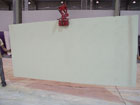
Pokarna’s factory allows for varieties of Quantra with a “veined” appearance.
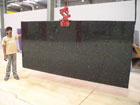
Elements such as steel, copper and other metals can be added to the mixture to develop a unique aesthetic
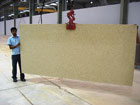
Production can also include slabs of quartz surfacing with a more “traditional” look



